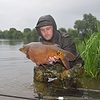Disclosure: Some posts contain affiliate links, which earn us a commission if you make a purchase through them. Positive Fishing © participates in various affiliate networks including the Amazon Services LLC Associates Program.
- Learn about the 12 most common bass species found in North America
- Learn how to identify them and their characteristics
- Understand where each type of bass live
Bass are one of the most common species sought after by anglers. Several species and subspecies can be found worldwide in both seawater and freshwater. Bass is a generic name given to fish that resemble the perch-like group they belong to.
They are one of the best fighting sport fish globally and are found mainly in the Northern Hemisphere, where we will focus this article.
Each type is grouped into either the black or temperate family.
1. Black Bass (Micropterus family)
There are 9 main species in the black bass group. Black basses have spiny and soft-rayed portions of the dorsal fin joined as a single fin. The largemouth and the smallmouth bass are anglers’ most loved game fish and can be easily recognized. They vary greatly between the different types, including their habitat, size, and where they can be found in the US.
2. Temperate Bass (Moronidae family)
Temperate bass inhabits the salt and freshwaters of North America, Europe, and Africa. They have double dorsal fins connected at their base. Most have slim bodies. The yellow, white, and striped bass are the most well-known species.
Most fish are between 12 and 18 inches long, but the star of the family, the “striper,” can grow up to 6 feet long with a weight of over 120 pounds!
Black Bass Species
Alabama Bass (Micropterus henshalli)
As the name suggests, Alabama bass is native to the Mobile River drainage of Alabama, Mississippi, and Georgia. Alabama bass looks very much like the spotted bass. Initially known as a subspecies of Spotted Bass, it was named a species in itself in 2008.
The Alabama bass is highly aggressive and adaptable, and they are a threat to other bass species as they outcompete or hybridize with almost any other bass species they come in contact with. They are considered invasive species.
Alabama bass grows very fast! Typically, it is 12 inches long within 3 years and up to 23 inches by 8 years. The largest fish ever recorded is over 11 pounds. Typically, they average around 2 pounds in weight.
It’s really difficult to determine the species from the spotted bass, and the best way is to count the scales along the lateral line. Alabama bass usually has 71 or more pored scales, and spotted bass usually has 70 or fewer – counting the scales is impossible whilst out fishing!
Alabama Bass has a blotchy lateral dark band along its length and has spots below this band. Typically, they have a tooth patch on their tongue,
They prefer flowing waters, small to medium-sized pools, and rivers over silt or gravel.
Florida Bass (Micropterus floridanus)
The Florida bass is primarily found in Florida. However, it has a relatively wide range of roaming and can be found in the Great Lakes, the middle Mississippi River, and most Southern US States.
Florida bass is often confused with the largemouth bass. However, the Florida bass has 69-73 scales along the lateral line compared to the northern largemouth’s 59-65 scales. Due to the warmer waters, they grow to trophy size much faster than the northern largemouth.
The largest Florida bass is recorded at 22 pounds. Typically, they average around 3 pounds in weight.
They inhabit brackish freshwater, including estuaries, rivers, and lakes. They prefer lots of vegetation, where food and cover are available.
Tip: While spawning, many male basses, such as the largemouth, prepare the nest, guard the eggs, and fry.
Guadalupe Bass (Micropterus treculii)
The Guadalupe bass is only found in Texas and is designated the state fish. The common sites of Guadalupe bass include the San Antonio, Guadalupe, and Colorado rivers and portions of the Brazos River drainage.
Their numbers are quite low, and most anglers practice catch-and-release techniques to increase fish populations.
Their lime green color extends lower along the body than the Spotted bass. They have a lateral line with separate diamond-shaped or circular spots. In older fish age, this fades from black to olive. On its back, there are many smaller diamond marks. They also have a rectangular toothpatch on their tongue.
The record fish is only 3 lb 11 1/4, and most fish are less than 12 inches long and under 1 pound in weight.
Guadalupe bass is usually found in streams and reservoirs. They prefer flowing waters and use natural cover such as large rocks or tree stumps for refuge. Smaller fish are often found in fast-moving water but then transition to deeper, slower currents after one year.
Largemouth Bass (Micropterus salmoides)
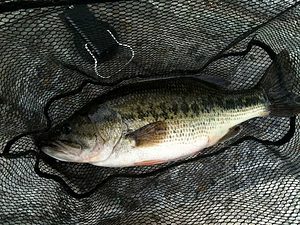
Largemouth Bass is often referred to as America’s most sought-after gamefish. Competitive and recreational fishing for largemouths is extremely popular in the US. The fishing tackle industry has grown hugely due to new types of fishing baits and gear designed for catching these incredibly popular fish.
The largemouth bass is native to the eastern and central United States, southeastern Canada, and northern Mexico but has been widely introduced elsewhere within the US. They can be located in the St. Lawrence River, the Great Lakes, Hudson Bay (Red River), and the Mississippi River.
The appearance of Largemouths can change, with colors ranging from olive to pale white and yellow with a prominent line of jagged splotches running from the gill plate to the tail.
Their preferred habitat is in clear waters with sandy bottoms and abundant vegetation. You can identify this species by looking at the mouth, extending past the rear edge of the eye. The dorsal fins are present in clearly separate sets, and the first dorsal fin has nine to eleven spines.
The average length for largemouth is 16 inches, with the longest recorded specimen being 38 inches long and weighing over 22 pounds. (caught over 90 years ago!)
You can read more on what is considered good-sized largemouth bass, including information on each state and where to catch them.
Redeye Bass (Micropterus coosae)
The Redeye bass is relatively smaller than most other bass species, and their growth rate is slower. They are native to the Coosa River system of Georgia, Alabama.
They typically range from five to sixteen inches long, and the average weight is approximately 1 pound. The largest fish caught on record is 5 pounds.
The Redeye is like most other basses, olive green in color. The upper jaw extends to the back of its red eye. The dorsal fin contains usually 10 spines and 12 rays. There is a small notched area between the two. The anal fin contains three spines and 10 rays. The complete lateral line has scales between 63 and 74. Redeye, like most bass, has a small toothpatch on the tongue. The back and sides are generally olive to brown with darker brown mottling.
Some anglers can be confused about distinguishing between the redeye and shoal bass. This is primarily due to the identical “red-tinted eyes”. However, to compare the two, look at the white edges of the upper and lower caudal fin.
They are found in cool streams and rivers in the foothills of mountains.
Shoal Bass (Micropterus Cataractae)
Shoal Bass are native to the warmer waters in Florida and Georgia. It has been declared an endangered species in Alabama and must be returned as a catch-and-release species.
The largest ever caught was a length of 24 inches and weighed almost 9 pounds. However, their average size is around 8 inches, and weighs typically less than a pound.
Anglers compare it to the smallmouth bass due to its similar faint vertical stripes along the side of its body.
Shoal bass are generally an olive green to nearly black along their back. A dusky dark blotch is found on the back edge of the gill cover. It also has three diagonal black lines on the side of the head. Ten to fifteen vertical blotches appear along the sides, with tiger stripes often appearing in between.
Shoalers prefer gravel bottom areas and water around 60 to 75 degrees.
Spotted Bass (Micropterus punctulatus)
Spotted bass are endemic to the Mississippi River basin and across the Gulf states, from Texas and the Florida panhandle. Its native range extends into the western Mid-Atlantic states and can now be found in western North Carolina and Virginia.
Spotted bass can reach an overall length of almost 25 inches and weigh up to 11 pounds.
They are similar in appearance to the largemouth, except for a slightly rounded body and a smaller mouth. Its name comes from its spots that are below its dark lateral line. The mouth does not extend past the eye when closed, and the base of the dorsal and anal fins have small scales. However, the latter can be identified by multiple dark blotches that touch the dorsal fin.
The Spotted Bass prefers cooler, clear waters with a gravel bottom and faster currents.
Suwannee Bass (Micropterus notius)
The Suwannee bass prefers water bodies with currents and eddies that sweep food in its direction. This species is native to just two river systems in the southeastern US, the Lower Suwannee and Ochlockonee River systems in Florida and a small part of Georgia.
Suwannee is one of the smaller bass types. Its average size is only around 8 inches and weighs 1 pound. It has a deep body with a large mouth and a round group of teeth on the tongue.
The base of the soft part of the dorsal fin and the anal fin are scaled. They are usually brown in color, and the flanks are marked with a dozen olive blotches.
It prefers the shallow parts of rivers that have a fast current and a limestone bottom.
Smallmouth Bass (Micropterus dolomieu)
Smallmouth bass is almost as popular as largemouth. It has been spread by stocking in many cool-water tributaries and lakes in the US. They inhabit the same lake systems as the largemouth but prefer the colder waters.
The maximum weight ever caught was 27 inches in length and 12 pounds. The average size is around 12 inches.
The Smallmouth bass is pale gold or green to dark brown with dark vertical lines. This fades to a lighter yellow towards its belly. Unlike the largemouth, its dorsal has no break between the two fins.
Adults live in shallow rocky areas of lakes and in the clear and gravel bottom runs and of cool flowing rivers. They can be found in both still and running water.
Tip: The jaw on the Largemouth bass is extended past the eye level. Smallmouth jaws are level with their eyes.
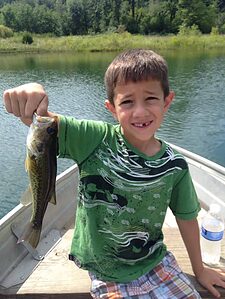
Temperate Bass Species
Striped Bass (Morone saxatilis)
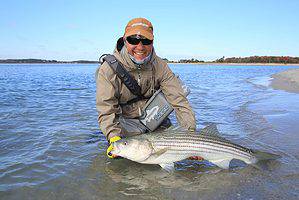
The striped bass, or “striper,” is a native of the northeastern Atlantic region but is also found on the Pacific coastlines. The largest fish are in the Chesapeake Bay, where they weigh between 30 to 50 pounds. An average fish is around 8 lbs and 20 inches in length.
They are green or brassy-olive in color, and the sides of the “striper” have seven or eight horizontal stripes. The sides and fins are paler in color.
The striped bass is the largest among the temperate bass. Its dorsal fin has a clear distinction between the spiny and soft rays.
They live in the ocean, only migrating to freshwater during the spawning season around April to June when the water temperatures reach 60 degrees.
Tip: Striped bass have no eyelids; they will move to deeper water to avoid the bright sunlight.
Yellow Bass (Morone mississippiensis)
The yellow bass is a native of the southern Mississippi Valley. Due to their small size, they are not so sought after by many anglers.
It is a light fish for its length, typically weighing one to two lbs but often measuring 12 to 18 inches long.
They are a brassy-yellow color, with seven very distinct dark horizontal stripes. The stripes are “broken” below the lateral line. Its body shape is oblong/oval, and it has an arched back. The dorsal fin and anal spines are wide.
Although similar to the white bass and the striped bass, it has no tooth patches on the tongue. The yellow bass differs further from the white bass by having nine or ten anal rays compared to eleven to thirteen on the white bass.
The yellow bass can be found in lakes surrounding the Mississippi and Tennessee rivers, especially in areas with dense vegetation and slower movement.
White Bass (Morone chrysops)
The white bass is a close relative of the striped bass and is native to many northern habitats. It has been introduced in many different waters around the United States, particularly in southern locations. They are widespread in Pennsylvania and the area around Lake Erie and southward in the Mississippi Valley to Arkansas. They typically grow to 12 inches, the longest being around 18 inches.
It has a silver color with a tinged golden belly, with dusky lines along the sides. They are sometimes called sand bass or silver bass.
White bass is a migratory open‐water fish. They spend most of their lives chasing their favorite food – schools of shad. The White bass is very active during the early morning or dusk.
They spawn in freshwater tributaries or on top of rocky shoals in lakes. Spawning occurs in the southern states in early spring and in May in the northern States.
White bass are distinguishable from striped bass by a single tooth patch on the tongue, while the striped bass has two tooth patches on the tongue.
White bass love lakes, ponds, and the pools of small to large rivers and prefer clearer water or areas with less vegetation. It prefers still waters rather than strong river currents.
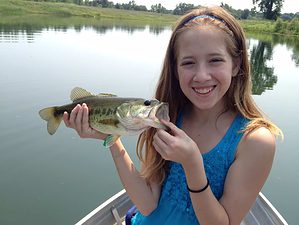
easy to catch and plentiful
Final Thoughts
Bass of all types are the most sought-after game fish for anglers in North America. The colors, shapes, and shades vary between species, but most anglers are not concerned about the type of bass they just caught. The thrill of the catch is more than enough!
Try to take some time to help kids learn to fish; kids have so much fun catching all kinds of bass, even smaller ones.
To help you catch more bass, check out my top bass fishing book choices, and my article on the best lures to use when bass fishing, which explains in detail which ones will give you an advantage the next time you go out bass fishing.
- 5 Best Fishing Bags For Getting Your Gear Organized - January 13, 2025
- 4 Essential Surf Fishing Rigs - January 11, 2025
- How To Know The Sex Of A Fish You Have Caught? - December 9, 2024

